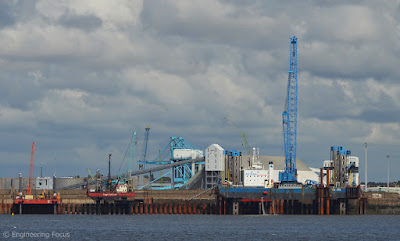Liverpool2 is the name given to the £300m deep water extension to the Seaforth Dock container terminal which is currently under construction on the banks of the Mersey. The extension will allow for 2 380m long "Post-Panamax" vessels to birth and be simultaneously loaded and unloaded. The new facility will open up the Port of Liverpool to 95% of the worlds global shipping fleet.
In order to ensure that 2 13,500 TEU (twenty-foot equivalent unit) ships can be quickly loaded and unloaded at a time, the port will eventually have a total of 8 "megamax" ship to shore cranes and 22 rail-mounted cantilever gantry cranes. These cranes will work together to swiftly load and unload containers and then stack them within the port for distribution by road, rail, canal or sea.
The port extension will double the port's current container handling capacity from 750,000 TEU to 1.5 million. Many containers will be loaded onto other ships for transport elsewhere nationally and internationally, whilst the rest will be transported by road, rail and via the Manchester ship canal.
The A5036 which connects the port to the M57 and M58 has already been upgraded to provide improved road links and the port is served by rail links connecting it to the national rail network. What is lesser known however is the part that the Manchester ship canal plays in transporting goods.
The Canal which opened in 1894 was originally designed to bypass the port of Liverpool and the excessive dues being charged at the time, but as ships got bigger traffic began to decline after a peak of 18 millions tonnes in 1958 to 7 million in 2005.
However the canal is now becoming increasingly important as the transport industry looks to reduce the number of journeys made by road. To that end Peel Ports who owns and operate Seaforth Dock and the Manchester ship canal are making use the canal in order to transport goods by container. Small 200 TEU vessels make regular trips from Liverpool to ports along the canal, reducing the number of journeys made by road.
Construction of the extension started in 2014 when crews began to install the first of the 296 piles which will make up the 854m long quay. The final piles are now being installed from a large jack up rig which has been a feature of the Mersey skyline for the past year.
The process of reclaiming 12 hectares of land behind the sea wall began earlier this year requiring 3 million cubic metres of material dredged from a site 20 miles away from the port. A specialist suction hopper dredger named Willem Van Oranje has been working on project collecting and depositing 21,000 tonnes of material at a time.
A major milestone to come in September (2015) will be the arrival of the the first 5 ship-to-shore cranes, each bigger than the Royal Liver Building. The cranes will arrive by ship from Shanghai and are so big they will be visible from 100 miles away.
- 5000 jobs created (400 direct jobs and 4,600 indirect)
- £5bn of economic benefit
- 854m long metre quay
- Costing £300m
- Will be able to handle 2x 13,500 TEU Post-Panamax ships at a time
- 12 hectares of land reclaimed
- requiring 3 million cubic metres of dredged material
The large jack-up rig installing the remaining piles
View of the 854m long quay
Pre-cast concrete capping segments being installed to form the sea wall
Recently constructed biomass silos
Hoper dredge Willem Van Oranje unloading material via a pipe leading to the quay










great
ReplyDelete